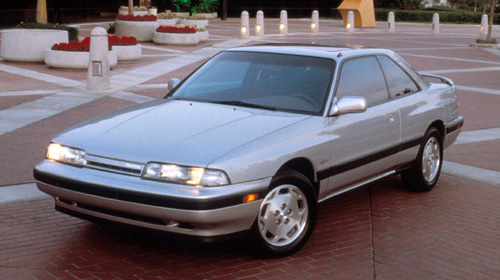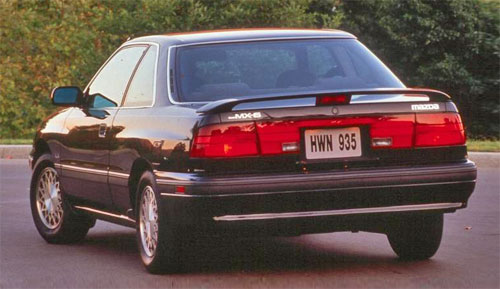FWD Champions: The ’88-’92 Mazda MX-6

There’s one of these at the house at the end of our road. A white one. I stare at it every time I drive by. Every time I stroll by its house during a walk with the kids, I have half a mind to ask the owner if he’d be interested in selling.
Even with the GT trim line’s 2.2l, 145 hp turbocharged 4-cyl engine, the first-generation Mazda MX-6 was never a screamer. 0-60 time was around 7.5 seconds—respectable for the era, but not necessarily quick. The style, too, was understated almost to the point of anonymity. The fascia in particular has no elements whatsoever that would distinguish it from your average Japanese sedan of the period. And to top it all off, the car was exclusively FWD. So what’s the big deal?

As with many cars I enjoy, what matters are the details, and what’s under the sheet metal. Study the car’s proportions for a minute. Notice the subtle fender flares and shape of the spoiler, among other cues. Remind you of anything? An R32 Skyline, perhaps? The car’s stance radiates a quiet undercurrent of mild aggression I find very appealing.
As nice as the shape is, the core of the first-gen MX-6’s draw are the mechanical bits. As mentioned above, the GT trim line was fitted with a 145 hp turbo’d 4-banger. The horsepower figure may not be much to write home about, but the many owners and enthusiasts feel it may have been underrated, and the torque number stands at a very stout 190 ft-lbs. Not only that, the nucleus of the engine itself served in a number of noteworthy sporting Mazdas, including the 323 GTX cult car and the first-gen Miata, and is well-known to be nearly indestructible, and very responsive to basic mods.

The ’88-’92 MX-6’s real party piece is illustrated above: The 4-wheel steering system. Offered around the world for the majority of the car’s run, but only in North America for the ’89 model year, Mazda’s 4WS system was very close in concept to that of the concurrent Honda Prelude. A computer-controlled steering rack was fitted to the rear wheels with the ability to turn them up to an angle of 5 degrees. The rear wheels turned the opposite direction from the fronts, tightening the turning circle and enhancing maneuverability, up to a vehicle speed of around 22 mph, at which point all four wheels turned the same direction, giving the MX-6 better high-speed stability. A system failure, or routine power down (as in turning the car off) automatically returned the rear wheels to straight ahead. Added weight and complexity, sure, but the car wasn’t that heavy or complex to begin with, it did mitigate some of FWD’s inherent disadvantages, and the cool factor is off the charts. Put all that together, and you have a worthy addition to our parade of notable FWD cars.
Editor’s note: This post is part of an ongoing series highlighting FWD cars I think highly of, in spite of my overwhelming RWD bias. Read the other installments here:
- Peugeot 205 GTI
- B4 Volkswagen Passat
- Lancia Fulvia Coupe
- Acura Vigor
- Mazda Millenia
- Citroën SM
- Fiat Coupé
- ’91-’96 Infiniti G20
- ’91-’94 B13 Nissan Sentra SE-R
- Audi Coupe GT
- Volkswagen Corrado
- Peugeot 405 Mi16
- ’78-’93 Saab 900
- Volvo 850 T-5R
- 5th-generation Honda Prelude
- 1st- and 2nd-generation Volkswagen Scirocco

While it was not up there with the 4th gen Prelude, the second gen Ford Probe, built off the same platform as the MX6 was a daring shape that held its market for an unprecedented several years. That was unheard of in a segment which ADD youngsters populated, No, it certainly had lousy brakes, and you didn’t want to risk owning an automatic but the V6 powered car with the larger tires was a pretty decent ride. If you didn’t find the “cone head” seats too off-putting.